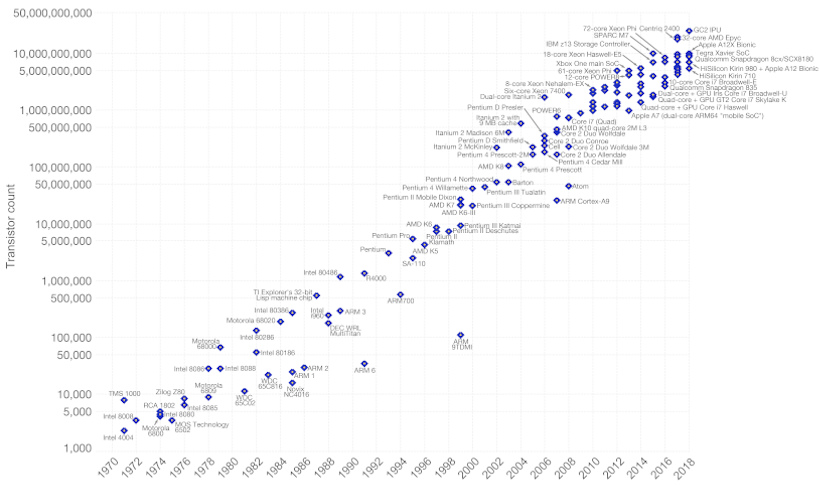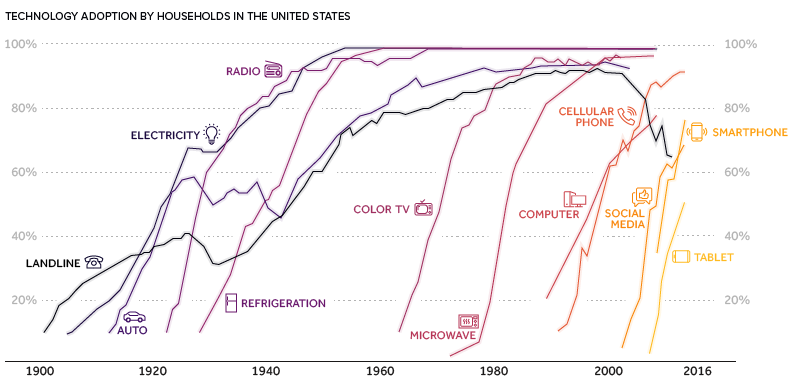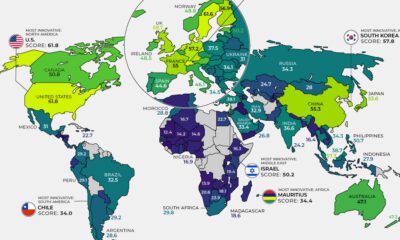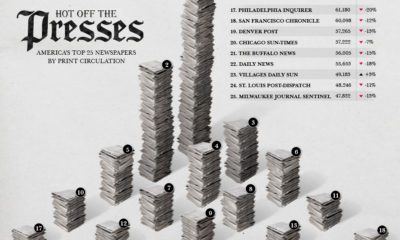There are many ways to show this, but perhaps the simplest way is to create a visual representation of Moore’s Law in action. Today’s animation comes to us from DataGrapha, and it compares the predictions of Moore’s Law with data from actual computer chip innovations occurring between 1971 to 2019.
Defining Moore’s Law
Moore’s Law was originally derived from an observation by Gordon Moore, the co-founder of Fairchild Semiconductor and later the co-founder and CEO of Intel. In 1965, Moore wrote that the number of components in a dense integrated circuit (i.e., transistors, resistors, diodes, or capacitors) had been doubling with every year of research, and he predicted that this would continue for another decade. Later on in 1975, he revised his prediction to the doubling occurring every two years. Like the animation, the following chart from Our World in Data helps plot out the predictions of Moore’s Law versus real world data — note that the Y Axis is logarithmic:
View full size image The prophetic prediction of Moore’s Law has led to exponential progress in computing — as well as for everything else touched by computers. It’s no surprise then, especially given that the modern information age is largely driven by increasingly efficient computing, that this law has had a trickle down effect on nearly every significant aspect of global innovation.
An Accelerated Pace of Change
Moore’s Law has translated into a faster rate of change for society as a whole. A new idea, like the smartphone, can get immediate traction because of instantaneous communication, increased global connectivity, and the ubiquity of information. New tech advancements can now change business or culture in a heartbeat:
Further, since software is a “layer” built upon the foundation of computing, it means that digital products can be replicated at almost no marginal cost. This is why a phenomenon like Pokémon Go was able to captivate 50 million users in just 19 days. Imagine this kind of scalability, when applied to things like artificial intelligence or virtual reality.
Is Moore’s Law Dead or Alive?
As with any enduring prediction, there are always naysayers out there that will boldly forecast an imminent end to the trend. Since the 2000s, there has been an ongoing debate within the semiconductor community on whether Moore’s Law will continue its reign, or if progress will ultimately sputter out as certain physical limitations catch up with the process of miniaturization. Earlier in 2019, Nvidia CEO Jensen Huang declared that Moore’s Law is no longer possible. For what it’s worth, Intel still says technology in chipmaking always finds a way to advance — while TSMC has recently said the law is actually alive and well. Regardless of who is right, Moore’s Law has held true for close to 50 years, and its repercussions will continue to be felt in almost every aspect of life and society going forward. on But fast forward to the end of last week, and SVB was shuttered by regulators after a panic-induced bank run. So, how exactly did this happen? We dig in below.
Road to a Bank Run
SVB and its customers generally thrived during the low interest rate era, but as rates rose, SVB found itself more exposed to risk than a typical bank. Even so, at the end of 2022, the bank’s balance sheet showed no cause for alarm.
As well, the bank was viewed positively in a number of places. Most Wall Street analyst ratings were overwhelmingly positive on the bank’s stock, and Forbes had just added the bank to its Financial All-Stars list. Outward signs of trouble emerged on Wednesday, March 8th, when SVB surprised investors with news that the bank needed to raise more than $2 billion to shore up its balance sheet. The reaction from prominent venture capitalists was not positive, with Coatue Management, Union Square Ventures, and Peter Thiel’s Founders Fund moving to limit exposure to the 40-year-old bank. The influence of these firms is believed to have added fuel to the fire, and a bank run ensued. Also influencing decision making was the fact that SVB had the highest percentage of uninsured domestic deposits of all big banks. These totaled nearly $152 billion, or about 97% of all deposits. By the end of the day, customers had tried to withdraw $42 billion in deposits.
What Triggered the SVB Collapse?
While the collapse of SVB took place over the course of 44 hours, its roots trace back to the early pandemic years. In 2021, U.S. venture capital-backed companies raised a record $330 billion—double the amount seen in 2020. At the time, interest rates were at rock-bottom levels to help buoy the economy. Matt Levine sums up the situation well: “When interest rates are low everywhere, a dollar in 20 years is about as good as a dollar today, so a startup whose business model is “we will lose money for a decade building artificial intelligence, and then rake in lots of money in the far future” sounds pretty good. When interest rates are higher, a dollar today is better than a dollar tomorrow, so investors want cash flows. When interest rates were low for a long time, and suddenly become high, all the money that was rushing to your customers is suddenly cut off.” Source: Pitchbook Why is this important? During this time, SVB received billions of dollars from these venture-backed clients. In one year alone, their deposits increased 100%. They took these funds and invested them in longer-term bonds. As a result, this created a dangerous trap as the company expected rates would remain low. During this time, SVB invested in bonds at the top of the market. As interest rates rose higher and bond prices declined, SVB started taking major losses on their long-term bond holdings.
Losses Fueling a Liquidity Crunch
When SVB reported its fourth quarter results in early 2023, Moody’s Investor Service, a credit rating agency took notice. In early March, it said that SVB was at high risk for a downgrade due to its significant unrealized losses. In response, SVB looked to sell $2 billion of its investments at a loss to help boost liquidity for its struggling balance sheet. Soon, more hedge funds and venture investors realized SVB could be on thin ice. Depositors withdrew funds in droves, spurring a liquidity squeeze and prompting California regulators and the FDIC to step in and shut down the bank.
What Happens Now?
While much of SVB’s activity was focused on the tech sector, the bank’s shocking collapse has rattled a financial sector that is already on edge.
The four biggest U.S. banks lost a combined $52 billion the day before the SVB collapse. On Friday, other banking stocks saw double-digit drops, including Signature Bank (-23%), First Republic (-15%), and Silvergate Capital (-11%).
Source: Morningstar Direct. *Represents March 9 data, trading halted on March 10.
When the dust settles, it’s hard to predict the ripple effects that will emerge from this dramatic event. For investors, the Secretary of the Treasury Janet Yellen announced confidence in the banking system remaining resilient, noting that regulators have the proper tools in response to the issue.
But others have seen trouble brewing as far back as 2020 (or earlier) when commercial banking assets were skyrocketing and banks were buying bonds when rates were low.















